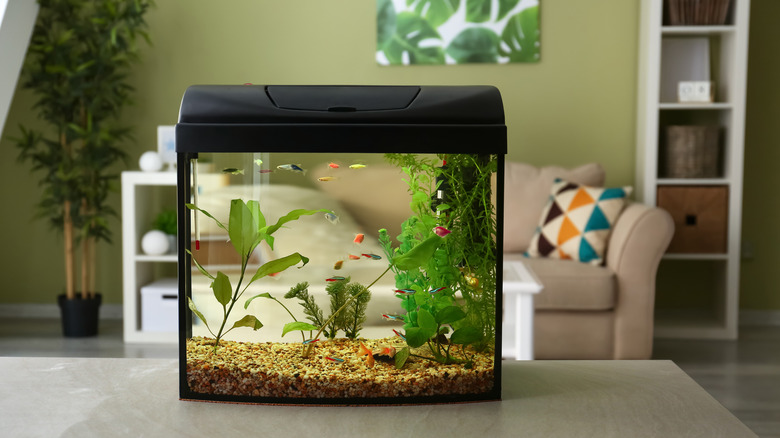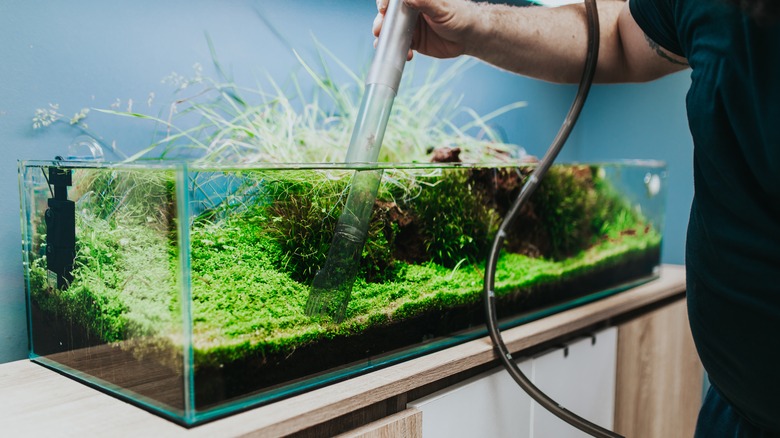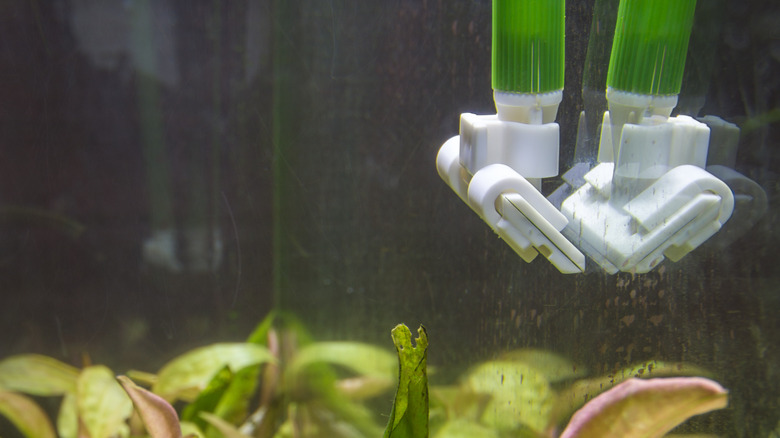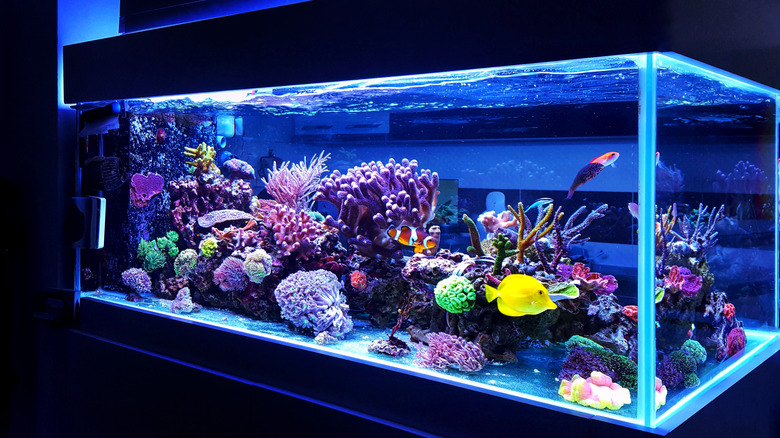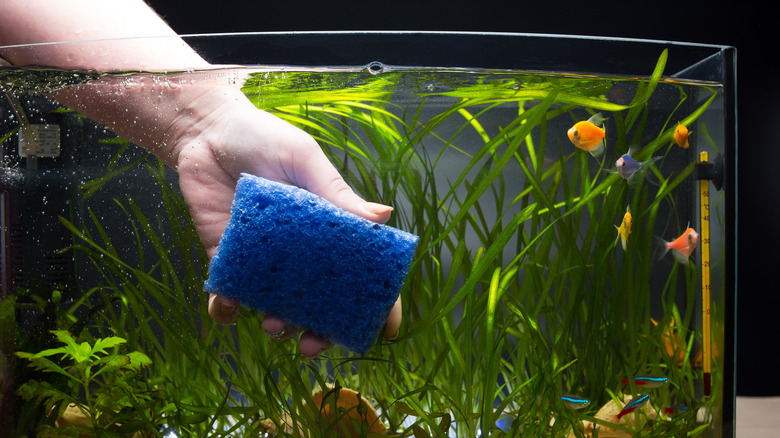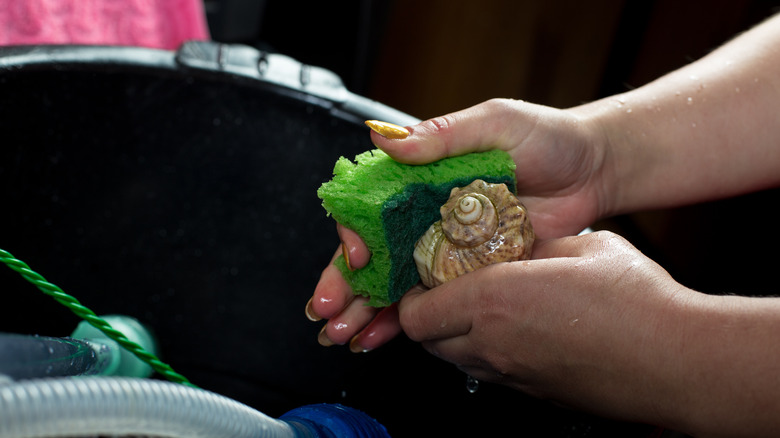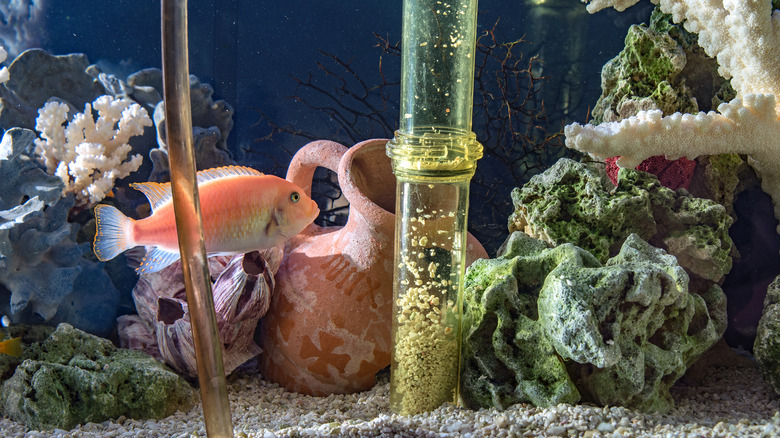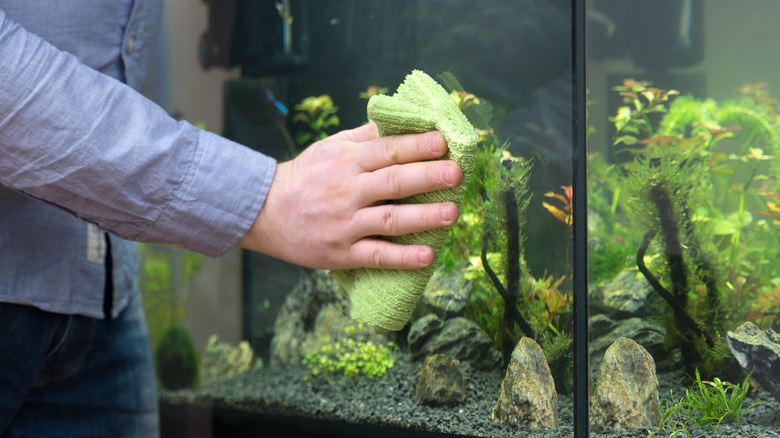Tips On Cleaning Your Fish Tank
Having a clean fish tank is not only important for your fish's wellbeing, but will also keep the water clear. Over time, different chemicals will build up in the tank, according to CD Aquatics, causing problems for your pet as well as creating a cloudy appearance. In fact, you should test the ammonia, nitrate, and pH levels of your tank once a month to make sure everything is kosher.
A quick cleaning of your fish tank should be something you do once a week, briefly scrubbing the inside glass and doing a partial water change. A partial water change is, in fact, always better than completely replacing the water as some of the old water contains beneficial chemicals for your fish. A full clean as described in this article can be done once or twice a month. However, you should check up on your fish daily to see if they are acting normal, or if they seem tired and sluggish or look like they're having a hard time breathing. All of these indicate the need to clean your tank and do a partial water change.
We understand cleaning the fish tank is not the best part of owning a fish, but it is absolutely necessary to keep your fish happy and living in a healthy environment. There are also a lot of things happening in that water that you can't always see, which is why even if everything seems normal, we highly recommend you stick to an appropriate cleaning schedule.
What to know before you begin cleaning your fish tank
First things first, you do not need to remove your fish from his tank while you clean it as all it will do is cause him unnecessary stress. According to Aquarium Co-op, since you need to be leaving in at least half of the tank full of water anyway, your pet will always be able to swim around. You can also leave plants and decorations in place during the cleaning unless they are visibly dirty. In that case, take them out, scrub them down and run them underwater.
We do recommend you follow the order of the steps in this article to clean your tank. Although it's not imperative, it will make the process simpler and more efficient. Ideally, the goal would be for this process to be quick and hassle-free. This means cleaning the inside glass first, decorations next, gravel, outside glass and fixtures, and finally the filter.
What you need to clean your fish tank
You're going to want to get yourself set up right for cleaning your fish tank, and that means having exactly the right items for the whole cleaning process. For starters, you'll need an algae scraper or algae pad for the inside glass depending on your tank. You'll also need bleach and a bucket (exclusively used for aquarium cleaning purposes) for decorations and plants, as well as a water siphon (also known as a gravel vacuum) for the gravel, aquarium-safe glass cleaner for the outside glass, and a filter brush, filter media, old bath towels, paper towels, bucket or big bowl, and chlorine remover.
Additionally, you will also need to set aside some time, although if you have a tank on the smaller side, 15 to 20 minutes should be enough to clean it thoroughly. If your aquarium is a little bit bigger you could need to set aside a good hour according to Neighbor.
What you should watch out for while cleaning your fish tank
Mainly you should be careful to be gentle when cleaning your tank since your fish is still in it. Other than that there are a couple of things that could be easy to forget and that are important to keep in mind. Firstly, you may forget to check the ammonia, nitrate, and pH levels of the water, so we recommend keeping a checklist of everything you have to do. This will help you not only do everything every time, but also keep track of the days you last cleaned your tank. In terms of the chemicals, Fetch by WebMD suggests that you write down and keep track of the levels for each to make sure they stay consistent.
In addition, although this should go without saying, keep an eye on your fish and check on both them and the tank daily to make sure nothing abnormal pops up. That could be a routine change for your fish, too much algae on the decoration, plants that are taking up too much space, an unusual smell, and so on — anything that could tarnish your fish's quality of life.
Cleaning the inside glass
Grab your scraper and get started on the inside glass by slowly scraping off all the algae. Go in an upward motion by starting at the bottom and move your way up to the top. Make sure to get every corner as some algae might have lodged itself very close to the gravel, for example.
This step is pretty self-explanatory and there really isn't a wrong way to do it. There are, however, different types of scrapers and you'll want to use the right one. For plastic aquariums, the regular metal scrapers are perfect and will do the job. However, for acrylic aquariums, it's best to use a plastic scraper or an algae pad instead since the metal would probably scratch the acrylic.
It's also important, according to The Spruce Pets, to buy any of the above in a pet shop as opposed to the houseware department of any other store. Although these tools can look the same, the latter could have chemical or soap residue that could harm the fish.
Cleaning the decorations
As mentioned previously, there is no need to clean the rocks and plants unless they are visibly dirty. If that's the case, take them out of the aquarium and scrub them down under some warm water. That should be enough to remove all the algae. Whatever you do, don't use soap or detergent since it will be hard to completely remove and could be harmful to the fish. If a good scrub didn't work, it's time to take out the bleach. Soak both plants and rocks in a 10% bleach solution for 15 minutes maximum. The Fishkeeping also suggests the use of a vinegar solution. Scrub off any remaining algae and rinse thoroughly in water before removing them and placing them on a used bath towel, letting them air-dry.
Leave rocks and plants out while you clean the rest of the tank, longer if necessary. The important thing to remember is to only put them back when the smell of chlorine has completely dissipated. If you're feeling impatient you can always soak them in water with some dechlorinator for a few minutes and it'll do the trick.
Cleaning the gravel
At this point, your fish tank should only contain your gravel and your fish. To clean the gravel, you'll want to grab your water siphon otherwise known as a gravel vacuum, and cover the entire surface of your aquarium with it. This step is going to stir up the gravel creating a bit of dust but there is no need to panic, it will settle down. The goal here is to vacuum up any debris leftover from scraping off the algae but also to get any fish waste, plant leaves, and such. Try and move the gravel around a little while you vacuum to really cover as much ground as possible.
According to Cuteness, there also is a way to clean your gravel without a vacuum. For this technique, you're going to want to take your fish out in order not to hurt him. Now grab a handful of gravel and set it aside; this will be the unwashed gravel that you'll put back to keep some of the good bacteria in the tank. Now simply remove the rest and wash it with some water, placing it in a clean, strictly for aquarium-cleaning-purposes strainer. Finally, put it back, as well as the unwashed handful.
Cleaning the outside glass and filter
If you've cleaned windows or mirrors, this step isn't going to be much of a mystery to you. Grab your glass cleaner and make sure it is aquarium safe (or use vinegar, that works as well) as most regular cleaners contain ammonia which is toxic for fish, or are extremely acidic like lime cleaners. Scrub all sides of your tank and then rinse it all with a clean damp cloth.
Once this is done, you can add any decorations and plants back in, as well as add water back to the tank. In a clean for-aquarium-purposes-only bowl or bucket add water that, according to Country Vet, should be the same temperature as the fluid already in the tank. Then add chlorine remover and let sit for 30 minutes. Half an hour later you can add your chlorine-free water to your tank, filling it up like before.
Finally, if you have a filter, cleaning it will need to wait two more weeks since it contains beneficial bacteria that will be able to replace the microbes you lost during the cleaning process. When cleaning, you should replace your filter media because past three weeks it's no longer serving its chemical absorbing purposes. If you have a filter medium, The Spruce advises you to gently rinse it and return it to its spot in the filter. Finally, grab your brush and clean the filter tubing, as well as all the different parts thoroughly but gently.
